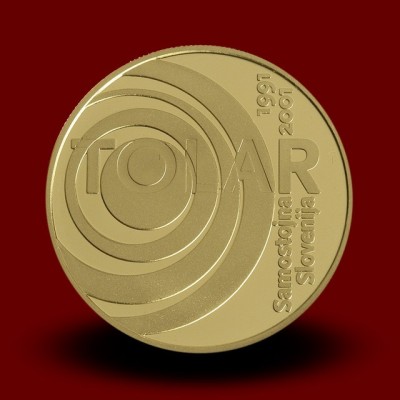| Masa | 7 g | ||
| Čistina | 900 / 1000 | ||
| Vsebnost zlata | 6,3 g |
||
| Mera kovanca (premer) | 24 mm |
||
| Nominala | 20 000 tolarjev |
||
| Leto kovanja | 2001 | ||
| Naklada | 1.000 kovancev | ||
Vir: Banka Slovenije
Po sprejetju ustavnega zakona o samostojnosti Slovenije je bil 23. decembra 1990 plebiscit, na katerem je 88,5 % vseh volilnih upravičencev glasovalo za samostojnost Slovenije. Po Zakonu o plebiscitu je morala biti osamosvojitev uresničena v 6 mesecih.
25. junija 1991 je Skupščina Republike Slovenije razglasila Temeljno listino o samostojnosti in neodvisnosti Slovenije. S tem je Republika Slovenija postala samostojna država. 23. decembra 1991 je bila sprejeta prva Ustava države Republike Slovenije. Skupščina Republike Slovenije je 25. junija 1991 poleg temeljne listine sprejela vrsto osamosvojitvenih zakonov. Z Zakonom o Banki Slovenije je postala Banka Slovenije centralna banka Republike Slovenije in bila med drugim pooblaščena, da izdaja bankovce in daje bankovce ter kovance v obtok.
Za uvedbo slovenske valute je 8. oktobra 1991 Skupščina Republike Slovenije sprejela dva pomembna zakona: Zakon o denarni enoti Republike Slovenije, ki določa, da je slovenska denarna enota tolar, in Zakon o uporabi denarne enote Republike Slovenije, ki določa tolar kot edino zakonito plačilno sredstvo v Sloveniji. In če je denar enako kot jezik sredstvo za sporazumevanje, je tudi naš tolar pomemben nacionalni simbol.
Ob 10. obletnici Republike Slovenije in tolarja – denarne enote samostojne Republike Slovenije, izdaja Republika Slovenija priložnostne kovance. Njihova oblika se podreja pravilu “cifra-mož”. Sprednja stran (“mož” – sporočilo izdajatelja) lahko s krogi simbolno predstavlja letnice dreves in ponazarja rast, vitalnost in vse večjo moč samostojne slovenske valute, lahko pa tudi valovanje vode v vodnjaku, v katerega si odvrgel kovanec. Črka “R” na desni strani smiselno dopolnjuje napis “Samostojna Slovenija” in pomeni kratico oblike državne ureditve, ki je bila uveljavljena hkrati z uvedbo samostojne valute. Na hrbtni strani so nominalna vrednost, ime izdajatelja kovanca in letnica njegove izdaje.
- Zlatnik z nominalno vrednostjo 20.000 tolarjev, s čistino 900/1000, s težo 7 gramov in premerom 24 milimetrov, v količini 1.000 kovancev.
- – -
10th anniversary of the Republic of Slovenia and the tolar – the currency of the independent Republic of Slovenia
Following the adoption of the Constitutional Act on the Independence of Slovenia, there was a plebiscite held on December 23, 1990 by which 88.5% of the eligible voters voted for the independence of Slovenia. Complying with the Act on the Plebiscite, the independence had to be gained within 6 months.
On June 25, 1991 the Assembly of the Republic of Slovenia adopted the Fundamental Charter on the Independence and the Sovereignty of Slovenia. Thus the Republic of Slovenia became an independent state. On December 23, 1991 the first State’s Constitution of the Republic of Slovenia was adopted.
In addition to adopting the Fundamental Charter, the Assembly of the Republic of Slovenia adopted a number of Independence Acts on June 25, 1991. The Bank of Slovenia became a central bank of the Republic of Slovenia by means of the Act on the Bank of Slovenia, and it was, inter alia, authorised to issue bank notes and to put bank notes and coins in circulation.
For the purpose of introducing the Slovenian currency, the Assembly of the Republic of Slovenia adopted two important Acts on October 8, 1991: the Law on Monetary Unit in the Republic of Slovenia, appointing the Tolar to be the Slovenian currency, and the Law on Use of Monetary Unit of the Republic of Slovenia, appointing the Tolar as the only legal tender in Slovenia. And if both money and language are a means of communication, the Tolar is a significant national symbol as well.
On the 10th Anniversary of the Republic of Slovenia and the Tolar – the Currency of the Independent Republic of Slovenia, the Republic of Slovenia hereby issues the anniversary coins. Their form conforms to the “heads and tails” principle. The obverse (“heads” – the message of an issuer) can symbolically represent annual rings by its circles and illustrate the growth, the vitality and the greater and greater power of the independent Slovenian currency, as well as representing the undulation of water in a fountain into which a coin has been thrown. The letter “R” to the right hand side sensibly complements the “Independent Slovenia” inscription and signifies the state order acronym, introduced together with the introduction of the independent currency. The reverse shows the nominal value, the name of the coin issuer and the year of the issue.
- the gold coin with a nominal value of 20,000 tolars, the 900/1000 purity, a weight of 7 grams and a diameter of 24 mm, in a quantity of 1.000 coins.
The authors of the idea for the design: Matevž Čelik, Domen Fras,MA, Vasja Semolič / Baterija, Ljubljana
Relief design: Jan Černaj, State Mint, Kremnica/Slovakia
Minting: State Mint, Kremnica/Slovakia
| Čistina | 900/1000 |
| Prevzem | * |
| Davek | Naložbeno fizično zlato je oproščeno plačila DDV po 118. in 119. členu ZDDV-1. |




